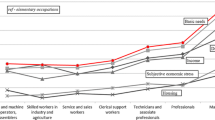Abstract
The paper reports on a study of indicators of well-being, including objective indicators of well-being, global, affective indicators of well-being, and indicators of socio-economic well-being. Socioeconomic well-being is (narrowly) defined as that part of the individual's universal well-being which is strongly related to money and material means.
It was hypothesized that these 3 classes of indicators of well-being have different meanings for the various groups of people on social security. Therefore, data were collected from a Dutch, nationally representative sample of 3 categories of individuals drawing benefits, namely: people receiving social benefits; unemployed, and disabled people, and a group of people in work. Hypotheses were tested regarding the following issues:
-
1.
the structure of the concept of well-being;
-
2.
predictors of happiness;
-
3.
well-being and social security.
The results indicate that, for the groups mentioned above, material aspects of well-being may be distinguished from immaterial aspects of well-being, and that indicators of socio-economic well-being contribute significantly to the prediction of happiness. Furthermore, these indicators discriminate best between people having employment and categories of individuals drawing benefits.
It is concluded that a socio-economic version of well-being may be highly relevant when studying the quality of life of people on social security.
Similar content being viewed by others
References
AndrewsF. M. and WhiteyS. B.: 1976, Social Indicators of Well-Being (Plenum Press, New York).
BradburnN. M.: 1969, The Structure of Psychological Well-Being (Aldine Publ. Co., Chicago).
CampbellA.: 1981, The Sense of Well-Being in America (McGraw-Hill, New York).
CantrilH.: 1965, The Pattern of Human Concerns (Rutgers University Press, New Brunswick, New Jersey).
DienerE.: 1984, ‘Subjective well-being’, Psychological Bulletin 95, pp. 542–575.
EasterlinR. A.: 1974, Does Economic Growth Improve the Human Lot? Some Empirical Evidence, in: P. A.David and W. R.Melvin (Eds.), Nations and Households in Economic Growth (Stanford University Press, Palo Alto, California).
FergussonD. M., HorwoodL. J., and BeautraisA. L.: 1981, ‘The measurement of family material well-being’, Journal of Marriage and the Family 43, pp. 715–725.
Groenland, E. A. G.: 1989, Dimensies van sociaal-economisch welzijn bij uitkeringsgerechtigden (Dimensions of socio-economic well-being of people drawing benefits). In press.
GurinG., VeroffJ., and FeldS.: 1960, Americans View their Mental Health (Basic Books, New York).
Huttman, J. P. and Liner, J. N.: 1978, ‘Economic and social indicators and the quality of life: defining the problem and fulfilling the need’, Labour and Society 3.
KammannR., FarryM., and HerbisonP.: 1984, ‘The analysis and measurement of happiness as a sense of well-being’, Social Indicators Research 15, pp. 91–115.
LarsenR. J., DienerE., and EmmonsR. E.: 1985, ‘An evaluation of subjective well-being measures’, Social Indicators Research 17, pp. 1–17.
McCallS.: 1975, ‘Quality of life’, Social Indicators Research 2, pp. 229–248.
MichalosA. C.: 1985, ‘Multiple discrepancies theory’, Social Indicators Research 16, pp. 347–413.
MorrisonD. G.: 1969, ‘On the interpretation of discriminant analysis’, Journal of Marketing Research 6, pp. 156–163.
NorusisM. J.: 1985, SPSSX Advanced Statistics Guide (McGraw-Hill, New York).
PommerE. J. and vanPraagC. S.: 1978, Satisfactie en Leefsituatie (Satisfaction and Life-Condition) (Sociaal en Cultureel Planbureau, Rijswijk).
RodgersW. L. and ConversePh.E.: 1975, ‘Measures of the perceived overall quality of life’, Social Indicators Research 2, pp. 127–152.
StrumpelB.: 1974, Economic Well-Being as an Object of Social Measurement, in: B.Strumpel (Ed.), Subjective Elements of Well-Being. (OECD, Paris).
StrumpelB.: 1976, Introduction and Model, in: B.Strumpel (Ed.) Economic Means for Human Needs. Social Indicators of Well-Being and Discontent (Institute for social research, Ann Arbor).
VeenhovenR.: 1984a, Data-book of Happiness. (1984). (D. Reidel Publishing Company, Dordrecht).
Veenhoven, R.: 1984b, Conditions of Happiness. Ph.D. thesis (Erasmus University, Rotterdam).
Warr, P. and Wall, T.: 1975, Work and Well-Being. (Penguin Books).
WeisbrodB. A. and HanssenW. L.: 1977, An Income Net-Worth Approach to Measuring economic welfare, in: M.Moon and E.Smolensky (Eds.), Improving Measures of Economic Well-Being (Academic Press, New York).
Author information
Authors and Affiliations
Rights and permissions
About this article
Cite this article
Groenland, E. Structural elements of material well-being: An empirical test among people on social security. Soc Indic Res 22, 367–384 (1990). https://doi.org/10.1007/BF00303832
Received:
Issue Date:
DOI: https://doi.org/10.1007/BF00303832




